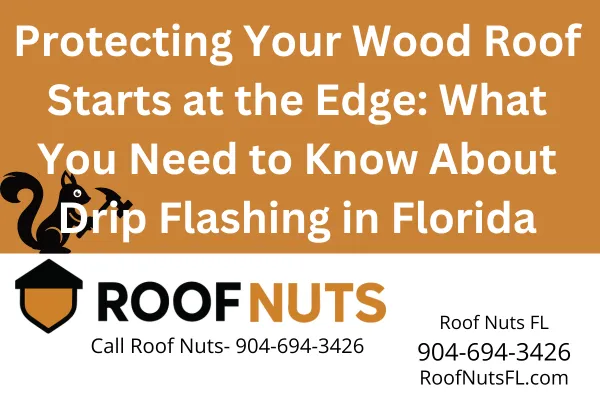
Why Edge Drip Flashing Is Critical for Wood Roofs in Florida
Protecting Your Wood Roof Starts at the Edge: What You Need to Know About Drip Flashing in Florida
Florida homeowners with cedar shake or shingle roofs often focus on the visible beauty of their wood roofing—but it’s the unseen details that keep that beauty intact. One of the most important components? Edge drip flashing.
At Roof Nuts FL, we install and repair wood roofs throughout Florida—from Jacksonville to Miami—and we’ve seen firsthand what happens when drip flashing is missing or installed poorly. Here’s what you need to know to protect your home.
What Is Drip Flashing and What Does It Do?
Drip flashing (or drip edge) is a metal trim that runs along the edges of your roof—typically the eaves and rakes. It redirects water away from the fascia, soffit, and underlayment, preventing rot and long-term damage.
For cedar roofs in Florida’s storm-heavy environment, edge flashing is essential.
Key Functions:
Directs water runoff into gutters
Prevents capillary action that can draw water behind the fascia
Shields the edges of wood shakes or shingles from wind-driven rain
Helps meet Florida Building Code requirements for waterproofing
Why Wood Roofs in Florida Require Proper Edge Flashing
Wood roofs naturally absorb moisture. Without proper flashing at the edge:
Water can soak into the decking and fascia
Cedar shakes may cup or split prematurely
Mold or rot can form behind the trim
Your roof may fail inspection during a sale or insurance renewal
In coastal areas like St. Augustine or Naples, salt air adds even more stress, making flashing even more important.
Recommended Materials for Florida Conditions
Not all drip edge is created equal—especially under Florida’s climate pressures.
✅ Use these materials:
Aluminum (pre-finished): Lightweight, corrosion-resistant, budget-friendly
Stainless steel: High-performance for coastal homes, resists rust
Copper: Beautiful and durable, ideal for high-end cedar roofs
❌ Avoid:
Bare galvanized steel—can corrode quickly in Florida humidity
Thin gauge metals—less resistant to wind uplift
We always install flashing using materials that comply with Florida Building Code and match your roof system’s expected lifespan.
Proper Drip Edge Installation on Wood Roofs
Here’s how we install drip edge flashing to protect your cedar shake or shingle roof:
1. Install Underlayment First
Synthetic or felt underlayment is installed over the roof deck and lapped correctly to shed water.
2. Set Drip Edge at Eaves
Flashing is installed beneath the underlayment at the eaves and secured with corrosion-resistant nails.
3. Apply Rake Drip Edge
At the gable ends (rakes), the flashing is placed over the underlayment to direct water away from the roof edge.
4. Overlap and Seal
Each piece of flashing overlaps the previous one by at least 2 inches. All corners and joints are sealed to prevent water intrusion.
5. Install Cedar Shakes or Shingles
Wood roofing is installed with correct exposure and spacing, allowing the flashing to remain hidden but functional.
FAQs: Edge Drip Flashing for Cedar Roofs
Is drip flashing required by code in Florida?
Yes. Florida Building Code requires metal drip edge at eaves and rakes on all steep-slope roofs, including wood roofs.
Can drip flashing be installed after the roof is finished?
It’s possible, but not ideal. The best time to install drip flashing is during roof replacement or major repairs.
How often should edge flashing be inspected?
At least once per year or after major storms. Look for rust, lifted edges, or sealant failure.
Will drip edge improve the lifespan of my cedar roof?
Absolutely. Proper flashing helps control moisture at the most vulnerable points of your roof, reducing shake damage and deck rot.
Start at the Edge—Protect the Whole Roof
The most overlooked detail on a wood roof is often the one that prevents the most damage. Drip flashing may be small, but in Florida, it’s critical.
If your cedar roof is missing edge flashing or showing signs of rot near the eaves, it’s time to act.
📞 Call Roof Nuts FL today at 904-694-3426 to schedule your wood roof inspection or flashing upgrade.
We serve all of Florida with expert care for wood roofing systems—done right, from the edge in.
